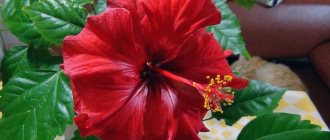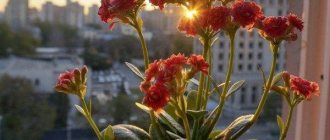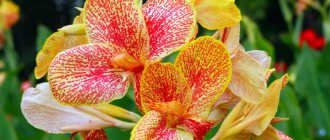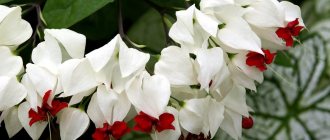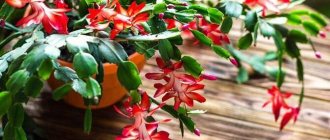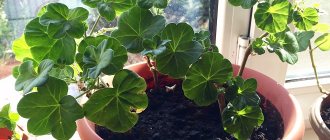Indoor hibiscus - description
Hibiscus belongs to the Malvaceae family. The genus Hibiscus includes about 500 species, varieties and hybrids of this extraordinary plant. Depending on the species, Hibiscus can be a tall tree, shrub or herbaceous plant.
What does it look like
Most indoor Hibiscus are branched shrubs or trees with an elegant trunk and many thin branches. The height of the plant, depending on the type, can vary from 0.5 to 2 m. The crop is perfectly moldable and easily tolerates pruning, thanks to which homemade Hibiscus can be given any shape.
Hibiscus leaves are large, shiny, dark green with jagged edges and a pointed tip. The leaf blades are on long thin petioles and are located alternately along the entire length of the shoots. Most types of Hibiscus have a single color, but there are also variegated varieties, the leaf blades of which are decorated with large and small spots of cream or white color.
When and how often does hibiscus bloom?
Homemade Hibiscus blooms from spring to late summer. Its flowers are arranged singly or collected in small inflorescences. They are funnel-shaped with open and gracefully bent wide petals of various shapes and colors. The base of the petals is fused. The diameter of the flower in different species can reach 20 cm in diameter. The flowers themselves can be simple, with five petals or more. There are double varieties and forms with wavy petals, which gives the flowers a particularly luxurious look. The center of the flower is decorated with a long pistil with many thin stamens.
It is noteworthy that the Hibiscus flower remains fresh only for 24 hours. At the same time, a bush can decorate from 30 to 50 buds, so when one flower blooms in the morning and fades in the evening, it is immediately replaced by another, thanks to which the plant retains its decorative effect for a long time. The color palette of Hibiscus buds is quite extensive and includes red, white, yellow, orange, carmine and pink. Flowers are often decorated with spots and streaks of bright contrasting colors.
After flowering, in place of the bud, a small fruit appears in the form of a seed capsule, which contains many small seeds. After the fruit ripens, it can be removed and the seeds can be used for sowing.
Why is Hibiscus called "Flower of Death"
Despite all the beauty of this plant, the rather ominous name “Flower of Death” has been assigned to Hibiscus. According to some beliefs, widespread in European countries, this plant is a harbinger of imminent death, a terrible illness of the owner or one of the family members. It is believed that if a plant blooms unexpectedly, this is a bad sign, meaning the death of one of the relatives. Therefore, if a plant has not bloomed for a long time and suddenly scatters with many buds, then superstitious owners burn it to avoid misfortune. But if the Hibiscus suddenly dropped all its leaves, then this is associated with the illness of family members.
However, these beliefs are widespread mainly in European countries, and in Asia Hibiscus is loved and respected. Moreover, according to the same superstitions, Hibiscus does not bring misfortunes into the house, but only warns about them, so you should not be afraid, but feel free to go to the store and purchase this beautiful and unpretentious plant. Proper care and compliance with maintenance requirements will help protect the owner from unnecessary worries and maintain a healthy, blooming appearance for the plant.
Homeland of the plant
In nature, Hibiscus can be found mainly in tropical climates in Asia and South America. In the wild, Hibiscus lives in China, Indonesia, Sri Lanka, Brazil, the islands of Fiji, Sumatra and Java. In Malaysia, this plant is considered a national treasure; in Hawaii it is called “the flower of beautiful women.”
Description
On one branch of a large plant, 10-20 buds can form in one day , which the next day will turn into large inflorescences 5-15 centimeters in diameter. On the entire tree, the number of simultaneously blooming flowers can reach 50.
The hibiscus flower is cup-shaped with single or double petals. In its center you can see several stamens collected in a tube. As for the smell, usually hibiscus flowers do not have it, but there are also very fragrant varieties.
How to care for indoor Hibiscus at home
The Chinese rose is an unpretentious indoor plant that is perfect for decorating any warm and bright room. For Hibiscus to feel comfortable, it is enough to pay a little attention to it and follow a few simple rules.
Lighting
You need to find a bright place in the house for Hibiscus. The plant prefers diffused lighting without direct sunlight, but if there is not enough light, it will simply refuse to bloom. Small bushes can be placed on the windowsill of a western or eastern window and protected from the summer midday sun with a light curtain. Large specimens are best placed on the floor near the south window.
Temperature
We must not forget that the Chinese rose is a tropical plant, so in the room where the Hibiscus grows, the temperature should not fall below +160C. In summer, the flower is kept at +20-+240C, and in winter, when flowering ends and its growth stops, it is advisable to provide coolness. In the cold season, Hibiscus is kept at +14-+160C. A cool winter is necessary for full growth and lush flowering with the arrival of spring.
Chinese rose does not tolerate drafts and sudden changes in temperature. In this case, the plant sheds its leaves and buds, so during airing the flower pot is taken out of the room.
Humidity
Humidity levels do not have a particular effect on the condition of Hibiscus. The plant feels great in dry climates, but it is more comfortable in high humidity, so it is recommended to regularly spray the bush with warm water from a spray bottle. You can increase the humidity in the room using a household humidifier, as well as a tray with wet expanded clay or moss. The flower pot is placed on a tray so that the bottom of the pot does not come into contact with water.
Watering
Hibiscus is quite critical of overdrying and waterlogging of the substrate, so the earthen ball is moistened regularly depending on the time of year and the needs of the plant. The plant reacts to overdrying of the earthen coma by withering and dropping leaves, as well as falling buds, while excessive watering often causes rot. For irrigation, it is recommended to use warm, settled water at room temperature.
In summer
In the warm season, from spring to late summer, water the Chinese rose abundantly as the top layer of soil dries out. On average, watering is done about 2-3 times a week.
in winter
In autumn, watering is reduced to moderate. The soil in the pot is moistened in small portions after the top layer dries slightly. Do not allow moisture to stagnate in the pot. During this period, the plant is also sensitive to drought, so it is necessary to monitor soil and air moisture.
Fertilizer - how to feed hibiscus
In order for the Chinese rose to have abundant color and delight with a thick crown all year round, it must be regularly fed with complex mineral fertilizers and organic matter. From spring to autumn, special compositions for flowering indoor crops are added to the soil along with watering 3-4 times a month. Mineral preparations can be alternated with organics, but strictly adhere to the dosage recommended by the manufacturer. From autumn to next spring, fertilizing can be suspended or reduced in frequency to once a month.
Pruning and crown formation
The Chinese rose has a fairly fast growth rate, so it needs annual pruning and pruning. Flower buds form only on branches of the current year, so you can mercilessly shorten old branches to ½ length, especially those that are weakened and have lost leaves. Pruning is carried out in early spring before flower buds set. This will help stimulate the growth of new young branches and abundant flowering, as well as form a lush crown.
Usually, homemade Hibiscus is left in the form of a spreading bush, but you can give it the shape of a trunk. To do this, using pruning, remove all lateral shoots, select the most powerful shoot and cut off the branches from the lower part of the trunk. The upper branches can be cut to the desired length and give the crown the desired shape.
Bloom
Syrian hibiscus (as it is scientifically called) is a member of the Malvaceae family. Within Russia, it is better known as the Chinese rose, or rozana . Admirers of hibiscus love it for its large and bright flowers of amazing beauty. However, often the plant refuses to please its owners with a scattering of buds, even if this beauty is cared for at the proper level.
Flowering period
The development of the Chinese rose occurs very quickly. As a result of proper care, it turns into an attractive tree and can bloom for several months.
Hibiscus is native to tropical climates, so in theory it can produce flowers all year round. But this is only possible if all the necessary conditions are provided: high temperature, good air humidity and a lot of bright sunlight.
When kept at home, the flowering of Chinese roses usually lasts for 2-3 months, starting in mid-summer and ending in the fall, in September.
buds
Hibiscus inflorescences are characterized by an exotic appearance and large size: fully opened buds are 9-16 cm in diameter.
The flower shape is cup-shaped, the inflorescences are either simple or double. In the center of each flower there is a pistil, which turns into stamens.
The vast majority of varieties of Chinese roses have flowers without any aroma, but there are also specimens with fragrant buds.
Typically, hibiscus flowers open in the morning, at sunrise, and wilt in the evening. With proper care, one branch can produce about 20 inflorescences during the day; on some large plants, up to 50 flowers can bloom simultaneously.
Rest period
The dormant period of the Chinese rose lasts from November to February. During these months, the plant is best kept at temperatures from +14°C to +16. During its dormant period, the hibiscus should receive enough light and moisture: a good level of lighting and moderate watering should be provided. It should be disturbed minimally at this time so that the plant can rest, gain strength and prepare for flowering.
The laying of new buds on Chinese roses occurs at a temperature no higher than +15°C. In February, hibiscus is placed closer to warmth and light, and the number of fertilizing and waterings is gradually increased.
You can also send roses for the winter by pruning them first. To do this, you need to give it the opportunity to shed its leaves in the fall. For this purpose, watering is gradually reduced to a minimum. When the hibiscus leaves fall, the stems are carefully trimmed, leaving “stumps” 6-8 cm long. Then the plant is transferred to a cool place (the ambient temperature should not be higher than +12°C). To prevent the root system of the Chinese rose from drying out, the soil must be slightly moistened from time to time.
Hibiscus propagation
At home, Hibiscus can be propagated using seeds, cuttings or dividing the bush.
Cuttings
The easiest and fastest way to get a new Chinese rose bush is to root the cuttings left after pruning. For this purpose, branches at least 10 cm long with several leaves are suitable. You can root Hibiscus in a glass of water or a pot with sand and peat substrate. After planting, the seedlings are covered with a bag and left for 3-4 weeks. The water needs to be changed regularly and the substrate moistened with soft warm water. Once the seedlings begin to show signs of growth, they are planted in pots with a suitable soil mixture. With quality care, they can bloom within 2 months after planting.
Seeds
Growing a Chinese rose from seeds at home is also not particularly difficult. Sowing is carried out from January to March in prepared wide bowls filled with a peat-sand mixture. In order for the seeds to germinate more quickly, they are pre-soaked for 12 hours in Epin’s solution. After sowing, the container is covered with film or glass and placed in a warm, bright place. It is necessary to maintain the temperature in the room around +25-+270C and monitor the humidity of the substrate. The greenhouse is ventilated daily, and the surface of the soil mixture is also periodically moistened. When seedlings begin to appear on the soil surface, the cover is removed. After a couple of true leaves appear, the hibiscus is transplanted into separate cups.
Dividing the root
Large bushes can be divided during transplantation. To do this, the plant is removed from the pot, cleared of soil, the rhizome is cut into several parts with a sharp knife and planted in different pots.
Myths and truth about hibiscus
It is believed that hibiscus in a person’s room causes him a constant feeling of melancholy and anxiety. This is actually a myth. Perhaps there really are unpleasant emotions when such a plant appears in the house. But, most likely, because most people today are familiar with the eerie signs associated with the Chinese rose. Then self-hypnosis takes effect.
But the information that such a plant is present on the coat of arms of Malaysia is true. In this place, hibiscus is loved and revered. In the capital of the country there is even a separate park in which more than 2 thousand specimens of the flower grow. Wedding ceremonies are often held there.
People call the Chinese rose “husband flower.” It is believed that the presence of such a plant in an apartment by all possible means expels representatives of the stronger sex from it. But it is very easy to refute this myth. After all, there are thousands of examples of happy wives admiring this flower in their home every day.
Transplanting a Chinese rose
Young Hibiscus need to be replanted annually, but older ones can be replanted only as needed. If roots begin to protrude from the drainage holes, this will be a clear signal to replant.
When to replant indoor Hibiscus
Transplantation is carried out in the spring, when the plant is just beginning to wake up from hibernation and show signs of growth.
Priming
Hibiscus is quite undemanding when it comes to soil composition, but it grows best on fertile, slightly acidic substrates (5.0-6.0 pH). You can use special mixtures for flowering indoor plants, but add a little sand, perlite or pieces of coal to them. Experienced flower growers advise preparing the soil yourself from humus, turf and leaf soil with the addition of sand in a ratio of 1/3/3/1. A little coal is mixed into the finished soil.
Pot
New dishes should be 3-4 cm larger than the previous one and have a sufficient number of drainage holes. If you plant a Hibiscus in a pot that is too spacious, it will concentrate all its energy on growing roots and will not bloom for a long time. You can use dishes made of any material, the main thing is that it is stable and does not tip over under the weight of the green mass.
During the procedure, it is not recommended to shake the earthen ball, so the flower is well watered beforehand, then carefully removed along with the substrate. 2-3 cm of expanded clay, pebbles or pieces of brick are poured onto the bottom of the new dish, then a small hill is formed from the prepared substrate, a plant is placed on it and all empty space is filled with earth. The root collar is not buried during planting.
Can I keep it at home or not?
First of all, it should be noted that all of the signs listed are based solely on people’s conjectures. Not a single assumption about the “bloodthirstiness” of hibiscus has been scientifically confirmed.
For example, it grows best in hospital premises simply because frequent ventilation and a lot of light in the corridors of clinics are ideal conditions for the comfortable life of the Chinese rose. In this way, all existing assumptions can be refuted.
If we talk from the point of view of floriculture, then growing such a plant at home is a pleasant and interesting process. Hibiscus is unpretentious. For it to grow well, enough daylight and a small amount of filtered water are enough. At the same time, it is not necessary to water the flower every day. On any botanical site, the user can find the optimal scheme for watering a plant.
If you regularly spray the Chinese rose with clean water and trim it from time to time, then an amazingly beautiful tree will appear on the owner’s window. The buds of its stunning flowers appear regularly and linger for 2-3 days.
Among the disadvantages of the plant are the high cost of its cuttings, the “love” of various pests for it, and active growth. Therefore, it is better to immediately allocate more space for hibiscus with sufficient light flow.
Diseases and pests of Hibiscus domestica with photos and their treatment
Chinese rose is a strong and strong plant that can easily withstand various adversities in the form of harmful insects and diseases.
Rarely, scale insects, spider mites and aphids appear on Hibiscus leaves. You can get rid of them with regular spraying, treatment with soapy water and special preparations. Insecticides are recommended for use in difficult cases. Then Actellik, Aktara and other pest control products are suitable.
Among the diseases, chlorosis and rot can be dangerous. In case of chlorosis, it is recommended to regularly fertilize the plant with special fertilizers, and also rinse it well in the shower with warm water. The sick flower is kept in quarantine until the situation improves.
If a rot disease occurs, you need to remove the Hibiscus from the pot, remove all damaged parts and treat it with fungicides. After this, the flower is transplanted into a fresh substrate.
Also, when growing Hibiscus, the following difficulties may arise:
- The falling of leaves and buds is a draft or a sudden change in living conditions.
- Stretching of stems, yellowing of leaves - lack of light. It is necessary to move the plant to a brighter place or illuminate it with a lamp.
- The leaves curl, the tips dry - dry air.
- Leaves become pale or yellow due to watering with hard water or iron deficiency. Watering should be done with soft, settled water, and the flower should also be fed with special preparations containing iron.
Often, if the rules of care and maintenance conditions are violated, the Hibiscus stops blooming. Most often this is due to:
- Lack of light or too intense lighting.
- Lack of nutrients.
- Lack of cool wintering and proper plant rest.
- Dry air and irregular watering.
- No pruning.
How to make Hibiscus bloom at home:
- Provide the plant with good lighting, warmth and regular watering.
- Check the pot. If the selected container for planting is too spacious, you may need to transplant the flower into a more suitable container.
- Feed the plant with special preparations containing potassium, magnesium and phosphorus.
- Provide cool rest from autumn to late winter.
- In early spring, trim all old branches to stimulate the growth of young shoots and increase bushiness.
If all conditions are met and the plant receives everything it needs for growth, then it will certainly delight with an abundance of bright and large flowers.
Caring for a houseplant after the buds wither
As soon as the flower has faded, it should be cut from the tree - this will preserve the plant’s energy for the appearance of new inflorescences.
At the end of the flowering period, the plant must be prepared for a dormant period:
- reduce watering;
- feed with fertilizer with potassium and phosphorus;
- prune branches;
- remove the pot with the plant from the bright sun;
- reduce the air temperature to +15+18 degrees.
Popular types of indoor Chinese roses with photos and descriptions
Despite the huge variety of Hibiscus species and varieties, not all of them are suitable for growing at home. Only a few varieties have gained particular popularity.
Cooper's or Variegated
A characteristic feature of this species is its variegated leaves, decorated with spots of white, yellowish and pinkish. In bright light, the foliage of this low shrub turns completely pink. In addition to the showy leaves, this variety of Chinese rose boasts bright and large flowers. The flowers of the plant are red; from the edge to the center the color of the petals becomes more intense, and the center of the corolla is decorated with an unusually curved pistil.
Changeable or Crazy Rose
A beautiful evergreen plant with double flowers and large leaves. At the beginning of flowering, the buds are creamy, but over time they turn white and then gradually turn pink. Each flower retains its decorative effect for up to 3 days, and at the end of flowering the petals turn purple.
Tequila Sunrise
One of the most unusual varieties with extraordinary flowers. The petals of the flower are peachy-orange with a red center. The pistil of the flower is decorated with a fluffy skirt of small petals of the same color.
Night runner
It is distinguished by incredibly beautiful large flowers, the diameter of which reaches 18-22 cm. The center of the flower is white and pink with a wide border of alternating red, blue and coral stripes. The edges of the petals are wavy with a yellowish edge.
Schizopetalus
People called it the “princess earring” for the incredible shape of its strongly dissected, bent orange-red petals. This gives the flowers a charming fluffiness, while their diameter reaches 5-8 cm. The variety is not large in size, but forms a spreading bush about 1 m high and up to 60 cm wide.
Tivoli
It grows as a low shrub with a powerful trunk and large flowers with pronounced relief veins. The diameter of the flower is about 15 cm. The flowers are red, single, with a yellowish border.
Beneficial properties of hibiscus for humans
Few people know that hibiscus is not only a very beautiful plant, but also useful for humans. The main thing is to use it correctly and study the list of contraindications in advance.
It is from the flowers of the Chinese rose that delicious red tea is brewed. The hibiscus drink perfectly quenches thirst even on the hottest days, and, in addition, invigorates and saturates with energy. If a person regularly drinks this tea, then he gets tired much less. Egyptians are sure that this drink also preserves youth, beauty, and sexuality.
Chinese rose is very useful for men and women of any age who are faced with heart and vascular diseases. Decoctions and teas from the petals of the plant help normalize blood pressure, cleanse blood vessels and strengthen their walls. If we talk in more detail about blood pressure, then cold hibiscus tea lowers it, and warm tea, on the contrary, increases it.
You can use various parts of the Chinese rose externally. For example, fresh flowers are crushed and applied to damaged skin that has boils or ulcers. This product speeds up the healing of burns.
If you use crushed flowers and leaves together, the resulting mixture can even cure malignant ulcers. This natural medicine becomes part of complex therapy and significantly speeds up the treatment process.
- Author: Maria Sukhorukikh
Rate this article:
- 5
- 4
- 3
- 2
- 1
(1 vote, average: 5 out of 5)
Share with your friends!
Is it possible to keep a Chinese rose at home: signs and superstitions
Homemade Hibiscus is undoubtedly a worthy home decoration, however, many superstitions are associated with this plant. For some gardeners, the energy that green pets bring is very important, so you need to study what effect this plant has on humans. In this case, you need to figure out what benefits and harms Hibiscus brings to the house.
It is recommended to place the Chinese rose in offices, educational institutions, and work rooms. Hibiscus helps stimulate creativity and improves mood. For people prone to laziness, depression and apathy, as well as low blood pressure, Chinese rose helps to tune into a positive mood, which contributes to greater productivity at work.
According to different beliefs, Hibiscus has a rather contradictory effect on the love sphere. It is believed that the flower is able to bring love and harmony into the life of a couple and refresh cold feelings. However, it is also generally accepted that the Chinese rose contributes to the rapid discord and separation of lovers, and a lonely girl who decorates her house with this plant is doomed to loneliness and will not be able to find a life partner.
There are several signs associated with the Chinese rose:
- If a plant blooms at an unusual time, this may mean the imminent death or serious illness of one of the family members.
- The beginning of Hibiscus flowering for an unmarried girl means imminent marriage, and for a married couple it means quarrels and separation.
- Withering, falling leaves, death of the plant - foreshadows illness and discord in the house.
To prevent Hibiscus from taking away the owner’s energy, it is recommended to place it in the corridor, hallway, living room, balcony or loggia. A flower pot cannot be placed in the bedroom or nursery. Also, the owners of this plant are wondering whether Hibiscus is poisonous or not. There is an opinion that the juice of this plant can be dangerous for children and pets. Of course, if pets and small children chew leaves and flowers, there is a high probability of poisoning and an allergic reaction, so you should not place a pot of Chinese rose in an accessible place. Despite this, it is quite difficult to call Hibiscus poisonous, since most undesirable reactions are associated with individual intolerance to the plant and careless handling of it.
Why is hibiscus called the flower of death?
It’s worth looking a little into history and finding out why the hibiscus or Chinese rose is called the flower of death? Much here is based on beliefs that the flower is a source of negative energy, which subsequently begins to absorb human strength and health; there is even another more malicious name - burnet . Most hibiscus flowers have a red tint, which is why they resemble the appearance of blood. But there are still varieties with a variety of colors.
There are also many beliefs that hibiscus does not simply take away vitality, but even brings a person closer to death. This is why all sorts of psychics and other specialists keep saying that you need to get rid of such flowers.
Others claim that the flower may be some kind of harbinger of misfortune. It will inform its owners about approaching trouble. For example, if a hibiscus has dropped its leaves, then it is safe to say that someone in the family will get sick.
This plant has both its negative and positive properties. For example, if you trust signs, then there is a belief that for a girl who wants to get married, this is the best remedy. Although a completely different belief insists that the flower is real evil and can bring sorrow to the family .
Its mystical properties are the main reason why hibiscus is used in various magical rituals and hexes. But do superstitions have any basis? It all depends only on you and your superstition. If you are not overwhelmed by doubts and prejudices and you want to purchase this flower shrouded in mystery, know: it will become an excellent decoration for your home. The main thing is not to forget about proper care of the plant.
Hibiscus in Chinese art by Hua Niao
The Hua Niao genre of painting, whose name translates as flowers and birds, was very popular in Ancient China. It was formed around the 3rd-6th centuries, but this type of art was especially popular in the first half of the tenth century. The artists' drawings glorified the beauty of nature and depicted flowers, birds, animals and insects. The founders of Hua Niao are considered to be the unsurpassed masters Huang Quan and Xu Xi. Flowers and birds were usually depicted on scrolls, fans, notepaper and album sheets. The principle of the genre is called “writing an idea,” so the artists tried to reliably convey the properties of nature and surrounding objects. Also, the drawings are characterized by some symbolism, understandable to the educated and high-ranking sections of the Chinese population of that time.
In Chinese art, Hibiscus symbolizes modesty, beauty, resilience and renewal. It was believed that drawings of this flower would bring abundance and prosperity to the home, so Hibiscus was often depicted in various genres. Hua Niao masters also loved to paint this plant, conveying its charm and subtle beauty. In paintings by artists during the Tang and Song dynasties, Hibiscus was often depicted with herons, ducks, and other birds and plants.
Hibiscus: transplantation and propagation
Hibiscus: Pixabay
If you plan to propagate or replant the plant, I will give some tips:
Hibiscus: transplant
Hibiscus is a plant whose replanting directly depends on its age. The young bush is replanted annually. After five years, it is enough to repeat the procedure every third or fourth year. An old tree does not need to be replanted; an annual replacement of the top layer of soil to a depth of several centimeters is enough for it.
The new landing container is selected so that it is slightly cramped. In an overly large pot, the rose will become more luxuriant, but it will produce fewer buds. The best option is a container 2 or 3 cm larger than the previous one.
When replanting, an earth mixture of leaf, turf and humus soil with sand (2:2:1:1) is used. For a young specimen, additional peat soil is added (2 parts). To prevent liquid from stagnating in the roots, a drainage layer is made at the bottom of the container using brick, expanded clay or ceramics.
Photos in the interior
The Chinese rose is one of the most beautiful indoor plants, which, with good care, can become the real pride of a gardener and the pearl of a home collection.
Reproduction
Hibiscus is propagated by round cuttings, but the most favorable time for cuttings begins in June and ends in September. Good shoots are trimmed, the flower is removed and planted in a mixture of peat and sand or in water. It is best to provide the cuttings with a greenhouse effect. In a greenhouse, cuttings take root quite quickly. Cuttings with roots are planted in the soil where they take root; rooting occurs within 2 months. The plant blooms a year after planting.
Popular types of hibiscus
Hybrid hibiscus (Hibiscus hybridus)
Hybrid hibiscus are herbaceous perennials with very large, bright, showy flowers. They are propagated in the spring (with the onset of stable warm weather, when the buds on the root collars begin to swell) by dividing bushes, green cuttings and grafting. These ornamental plants are good for large flower arrays, mixed borders, parterres, boulevards, edges, banks of reservoirs; they are planted in clearings in parks and among rare bushes in the southern regions of Russia.
Chinese hibiscus (Hibiscus rosa-sinensis)
Chinese hibiscus, or Chinese rose, grows in East Asia and the Pacific Islands. Introduced into Europe at the end of the 17th century. About 500 varieties are known. A very decorative evergreen shrub, the height of which (at home) reaches 3 m. In cultural conditions, this is a very well-known greenhouse and indoor plant. The leaves are dark green, glossy on top, oval or ovate-elongated, serrated along the edge. Chinese hibiscus blooms from early spring to late autumn. The flowers are large (12-16 cm in diameter), simple, semi-double, of various colors - from fiery and orange-red to pink and yellow, depending on the variety.
Chinese hibiscus, or Chinese rose (Hibiscus rosa-sinensis). © floradania
Some varieties:
- Anita Buis - flowers are simple, yellow-orange.
- Florida - flowers are large (up to 14 cm in diameter), orange-red.
- Hamburg - large, double, carmine-red flowers.
- Rosa - semi-double and double flowers, salmon pink.
Hibiscus schizopetalus
Dissected-petaled hibiscus can be found under the synonym Chinese Hibiscus, variety - dissected-petalled (Hibiscus rosa-sinensis var. schizopetalus). Homeland - Central Africa. A shrub with thin shoots and shiny green leaves. Red-orange flowers with a diameter of 5 cm with bent petals, deep and uneven fringe. Greenhouse and indoor plant.
Hibiscus schizopetalus. © erica
Syrian hibiscus (Hibiscus syriacus)
Syrian hibiscus comes from China and India. Its original exotic flower is a symbol of the island of Haiti. Local residents and numerous tourists decorate themselves with it. In some provinces of India, red and pink flowers are woven into wedding wreaths.
Syrian hibiscus (Hibiscus syriacus). © m.sudarevic
